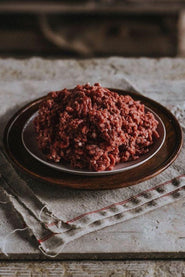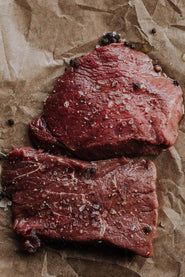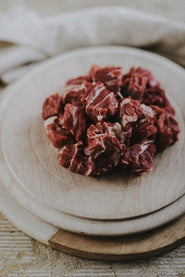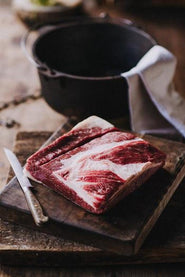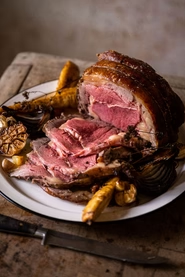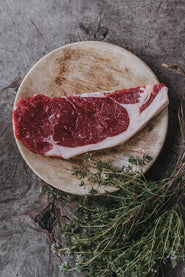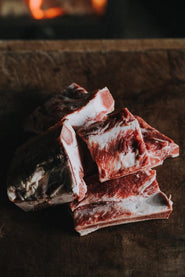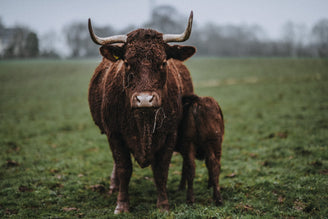Grass fed beef is more nutritious, better for our health, our environment, the welfare of animals and for the communities of farmers who are producing it.
As Sustainable Food Trust founder Patrick Holden said this week
“When managed holistically livestock play a critical role in conservation and increasing biodiversity – and may even play a part in reducing atmospheric carbon. As such, they should be seen as a cornerstone of sustainable farming systems.”
We’re exploring why we believe that in order to reduce our climate impact we have to change the mantra that all meat is bad for the planet. In fact we would go so far to say that Grass Fed Beef can save us all…
Grass Fed Beef is Better for Our Health
Grass fed beef contains significantly higher levels of conjugated linoleic acid (CLA) than meat from grain-fed animals. This is because grain-based diets reduce the pH of the digestive system in ruminant animals, which in turn inhibits the growth of the bacteria that produce CLA. When ruminants are raised on fresh pasture alone, their meat contains three to five times more CLA than similar products from animals fed conventional grain based diet.
Grass fed meat also contains higher vitamin and mineral levels than meat from grain-fed animals. It is particularly rich in vitamins A and E, and minerals such as calcium, magnesium and potassium.
Carotenoids, such as beta-carotene, are precursors to vitamin A and are found as pigments in plants. Grain-fed beef does not contain appreciable levels of carotenoids, for the simple reason that grains do not contain them. However, cows that eat carotenoid-rich grass and forage incorporate significant amounts of these compounds into their tissues.
Grass-fed beef also contains significantly more of the antioxidants vitamin E, glutathione and catalase. These antioxidants play an important role in protecting human cells from oxidation, especially delicate fats in the cell membrane including the omega-3 and omega-6 types.
Along with the complex vitamins found in grass-fed beef, you’ll also find higher levels of beneficial minerals including zinc, iron, phosphorus, sodium, and potassium that are vital to our health.
Now we know it's better for us, what about the planet?

Grass Fed Beef is Better for the Environment
Cutting back on the biggest pollutant (man-made fossil fuels) is very important to reverse climate change. Grass based systems utilise what nature has in abundance and work on much lower and in many case minimal inputs. There is less need for large farm machinery fulled by diesel, as the cattle are harvesting their own food in the most natural way.
Factory meat farms providing grain-based diets are feeding protein using habitat destroying foods such as soya, or mono-crop systems like intensive wheat and corn. This includes the use of huge fossil fuel guzzling equipment on land that has been cleared of diversity, leaving just the single crop that’s growing. A lot of the soil biology has been destroyed due to excess tillage or chemicals poured on the land.
Historically all our farmland was a mix of forage, vegetation, grasses and woodland which would have been home to huge varieties of native plants, insects, and animals like mice, nesting birds, foxes, badgers, moles and deer. In a mono-crop system this entire ecosystem has been destroyed and in its place a single crop laid.
High levels of organic matter are the basis for soil fertility, releasing nutrients for healthy plant growth. The amount of organic matter present in the soil is essential to reverse the effects of climate change.
By introducing grasses, herbs and clovers that build soil organic matter, which is then grazed by ruminant animals on rotation, who fertilise the soil, results in a balanced natural ecosystem that; regenerates topsoil, increases biodiversity, improves water cycles and increases resilience to climate fluctuation.
Joel Salatin suggests that not only can grass fed beef feed the world but it’s the only system that will. “The industrial food paradigm views life from a mechanical point of view. Food is a machine, and the way they go about producing it depletes the soil and burns up energy. Our way of producing food is based on abundance, not depletion. We rejuvenate the soil and lock up carbon so that food can continue to be produced”.
How Can Grazing Cattle on Grass Help Climate Change?
Call it rotational grazing, mob grazing, holistic planned grazing, cell grazing… there are slight nuances in the management of the grazing type, but the fundamental principals of the practice are based on the idea of grazing a large amount of cattle, on a small amount of land, for a very short period of time.
The aim of mob grazing is to mimic natural movement and behaviour of wild herbivores, where animals would move through the land in herds. In the wild, grazing animals move in groups, intensively grazing one patch then moving on to another. They move around in ‘mobs’ clearing a site and then moving on.
Mob grazing is a vital part of the way we manage our farm, the practice ensures our cattle interact with the sward in a way which enhances soil and pasture health, and thereby improving environmental and animal health.
The cattle are grazing pasture to the beginning of the root, taking up all the nutritional value of the grasses. Once cattle have repeatedly chewed the cud with their strong molar teeth, they mix the forage with their gut flora, so that no nutritional value is wasted. Their dung, returned to the pasture from a healthy gut, provides food for insects, and the billions of soil bacteria, which create sustainable biodiversity.
Mob grazing ensures that manure is spread more evenly to the pasture. As the cattle are on a small strip of land, instead of cattle returning their dung to one corner of a field, they are spreading the dung, and all the brilliant nutrition living within, more evenly across the entire pasture, nourishing more of the soil and pasture in turn. The cattle will tightly trample some of the longer grasses into the earth which also incorporates more organic matter into the soil.
By keeping the cattle on a tighter strip of land we are giving the pasture a chance to recover fully before being re-grazed. This provides better ground cover with longer grass and a more extensive root which means that water infiltrates much better too, reducing flooding and mitigating drought. The long grasses also create a haven for wildlife, including nesting birds and billions of bugs and bacteria that thrive in a carefully balanced ecosystem.

How Can You Make a Difference?
We all have the ability to make a choice about the food we eat and the system in which it is produced. By choosing to buy Grass Fed Beef you can not only eat some of the finest meat on the planet, but you’re choosing to nourish your body and our planet in the process.


